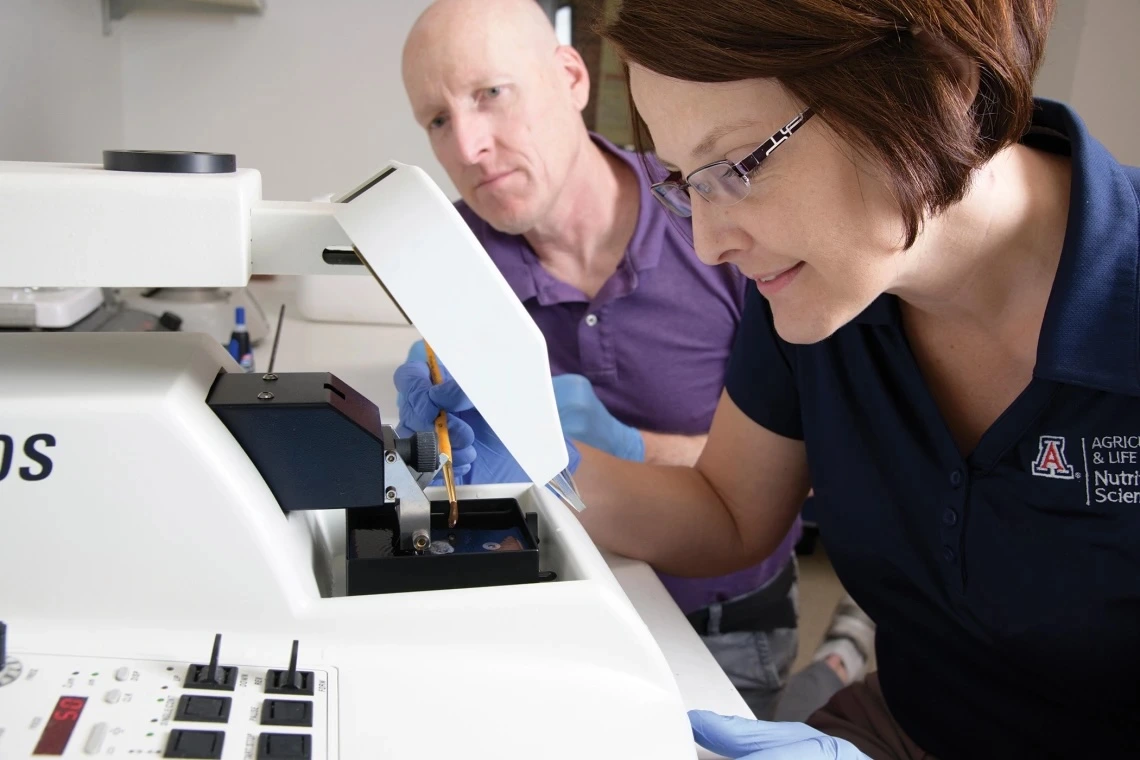For cancer survivors, full recovery requires precision healing

Kirsten Limesand, a professor in the College of Agriculture, Life and Environmental Sciences, investigates how the body's own immune cells may be preventing the salivary glands from healing and how shifting these cells' metabolism might turn the healing back on.
Kris Hanning/University of Arizona Health Sciences
Kirsten Limesand is seeking to understanding why salivary glands fail to recover after radiation.
"We're getting better at treating cancer," said Limesand, a professor in the School of Nutritional Sciences and Wellness in the College of Agriculture, Life and Environmental Sciences. "And yet patients are asking, 'What's my life going to be like on the other side?'"
For head and neck cancer survivors, that question can linger long after the last radiation treatment. Life on the other side of cancer often comes with a quiet struggle: the loss of saliva.
That's because while radiation is used to target tumors, it can also damage healthy surrounding cells, including the salivary glands. Roughly 70% of head and neck cancer patients experience xerostomia, or chronic dry mouth.
"Dry mouth" may sound minor, but for survivors it's life-altering – affecting speaking, eating, tasting, sleeping, digestion, dental health and overall quality of life.
"Patients find me on the internet and send these incredibly distressing stories about how their lives have been disrupted. They're grateful to be cancer-free, but they're miserable," said Limesand.
"Even if I only get one email a year, it's enough to remind me there are hundreds of thousands of patients just like them."
Immune cells: Balancing repair and resistance
To understand why healing stalls, Limesand's team is turning their attention to the immune system.
Supported by a new $3.1M National Institutes of Health grant, Limesand and her research team are investigating how the body's own immune cells may be preventing the salivary glands from healing and how shifting these cells' metabolism might turn the healing back on.
"Immunology and inflammation are kind of like the Goldilocks story. Too much is not good, too little is not good," she said. "This entire grant is about understanding that 'just right' balance."
That sweet spot – when the immune system knows when to act and when to stand down – is central to how the body heals itself. It's the same principle that keeps the immune system from attacking healthy tissue. When that regulation breaks down, repair can stall.
A 'traffic jam' of cells
Limesand's lab has already found that immune cells can linger in the glands months after radiation. Some of them appear to help with repairs, but others seem to get in the way.
The troublemakers seem to be double-positive T cells. Normally, these cells are found in the thymus, where they're maturing, Limesand explained. "Seeing them out in the tissue is a sign something's gone wrong."
The researchers think these rogue, immature cells somehow slipped out before they were ready and aren't listening to the regulators on the scene.
"The Tregs [regulatory T cells] are trying to control the situation, but the double positive cells keep accumulating and exhibiting markers of activation," Limesand said. "It's like a traffic jam of immune cells that won't stand down, and the tissue just can't heal."
By mapping where these double-positive cells cluster and what molecular cues they're sending, Limesand's team hopes to see how they interfere with the gland's recovery and how the body's normal regulators, the Tregs, might restore balance.
The metabolism connection
The team suspects the key may lie in immunometabolism or how immune cells use energy to fuel their behavior.
"Immune cells make and secrete a cocktail of molecules that influence their surroundings, but the messages they send depend on their metabolic state," Limesand said. "When we see those pathways activated, we know the cell is in 'go mode,' producing signals that could either promote or block healing."
Her group has already seen that metabolism can make the difference in treating other conditions, such as type 2 diabetes.
"Metformin is taken by millions of Americans for diabetes. We know it changes metabolism in certain cells, including immune cells. What's fascinating is that when we give metformin to irradiated salivary glands in our model, they start to function again," Limesand said. "It's the same drug, just a new purpose."
Interestingly, the researchers have seen that metformin only helps when certain immune cells are present. Determining which ones are beneficial or detrimental is key.
Toward precision healing
What Limesand and her team hope to build is a kind of roadmap, one that shows which immune populations appear at different stages after treatment and how each influences recovery.
"We'll be able to treat patients with more precision," she said. "It might matter whether you're one month, six months, or two years after treatment, but understanding that landscape means we can target therapies when they'll actually help."
She calls it precision healing, an approach focused not on fighting disease, but on rebuilding health. And because the team's single-cell and spatial data will be shared on open-access platforms, the discoveries won't end there.
"These technologies give us enormous data sets that scientists anywhere can use to ask new questions," Limesand said. "Maybe someone studying a completely different disease will see something unexpected that changes everything. That's the beauty of science, that serendipity is why we do what we do."
A version of this story originally appeared on the College of Agriculture, Life and Environmental Sciences website.





